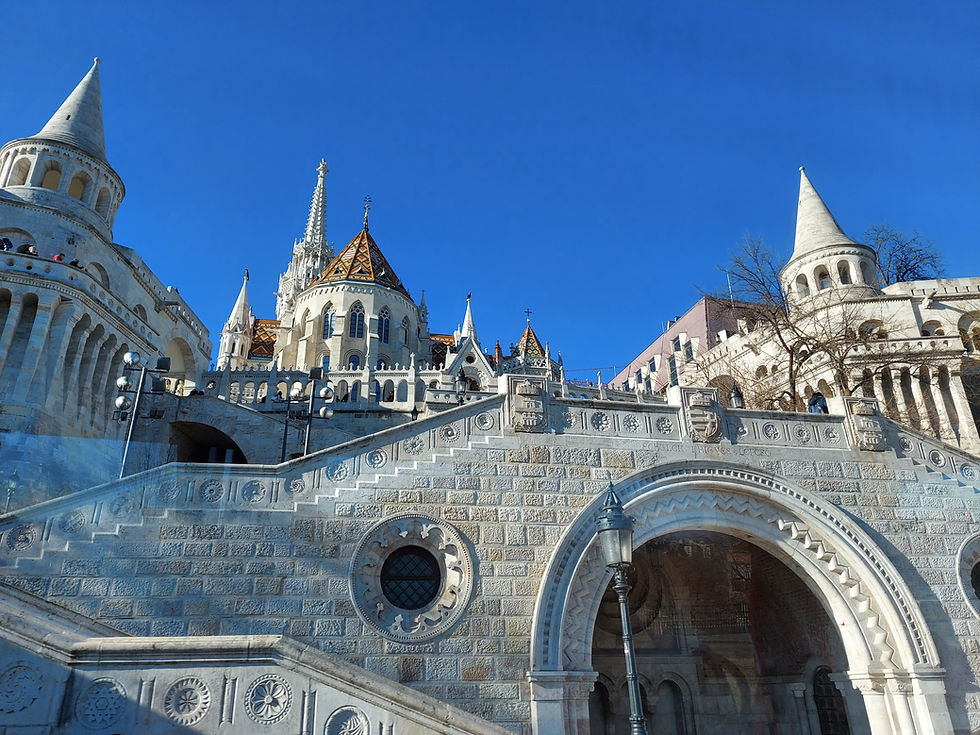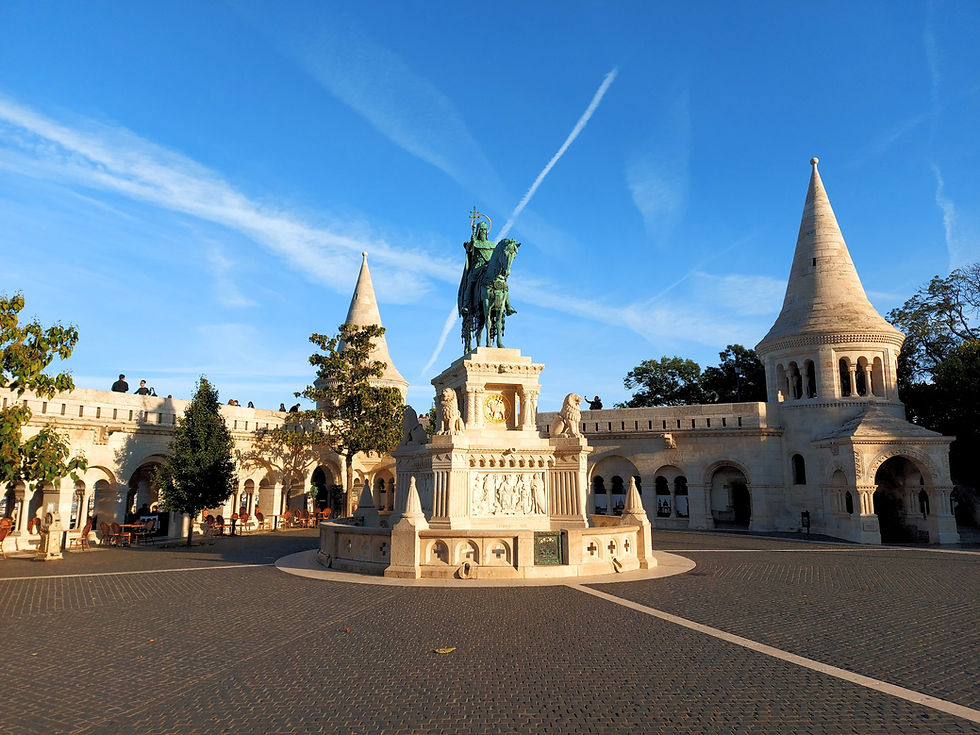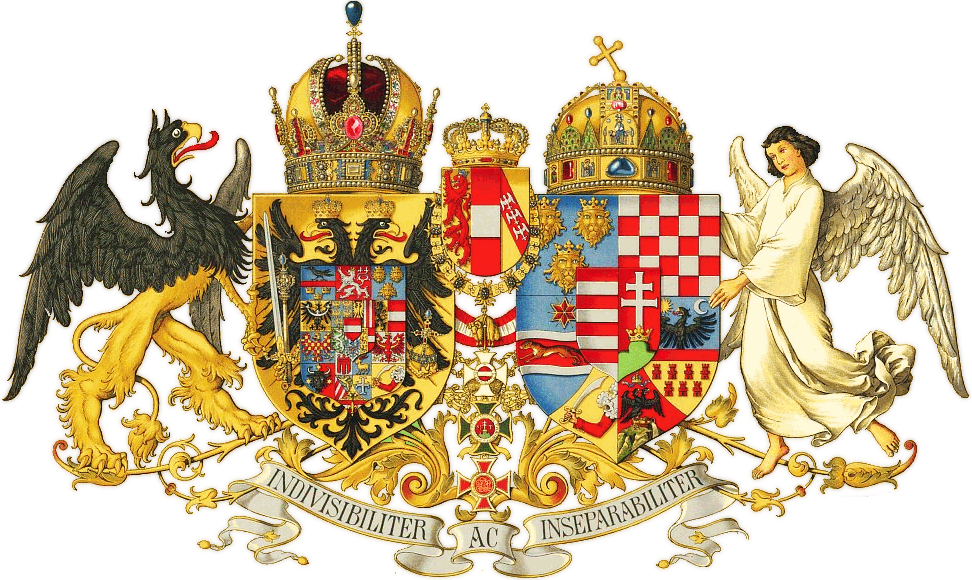The Matthias Church and The Fisherman's Bastion in the Castle District
- Gems of Budapest

- Jan 28, 2025
- 9 min read
Updated: Aug 19, 2025
Located within the enchanting Castle District in Budapest, lies a gem of Hungarian history and architecture – the Matthias Church (in Hungarian: Mátyás Templom). Standing as a symbol of resilience, beauty, and spiritual devotion, this magnificent church offers visitors a glimpse into Hungary's rich past and cultural heritage. With its stunning Gothic architecture, captivating interior, and panoramic views of the city, the Matthias Church is a must-visit destination for any traveler exploring the heart of Budapest. Next to the Matthias Church, the Fisherman's Bastion (in Hungarian: Halászbástya) offers great views of Pest. Together, these two landmarks form a harmonious ensemble that reflects Hungary's rich heritage and medieval charm.

Where to find it?
Holy Trinity Square, Budapest, Hungary, in front of the Fisherman's Bastion at the heart of Buda's Castle District
How to get there?
By Bus: 16A Bus from Szell Kalman Square (M2 metro station) or 16 Bus from Deak Square (M1, M2, M3 metro lines)
By Funicular: From Clark Adam Square to the Castle Hill, and an approx. 10-15 min walk from the Funicular
Opening Hours of the Matthias Church: (Subject to Church Events)
Mon-Fri: 9 am – 5 pm
Sat: 9 am – 12 pm (Midday)
Sun: 1 – 5pm
Liturgies / Weddings have priority, and will affect regular Opening Hours.
Ticket to the Matthias Church
In the church, liturgical events and state delegations have priority, the opening hours may change depending on this. Please be sure to check the website for current opening hours and tickets:
Ticket to the Tower of the Matthias Church
Please note that the tower ticket includes a short 10-minute guided tour. You can find the exact start time of the tower tour on the ticket you purchased. In order to start on time, please arrive 5 minutes earlier at the entrance of the tower, where the tower tour will begin. The panoramic terrace can be reached by climbing 197 steps. Please note that there is no elevator or washroom in the tower.
Family ticket
In the case of two adults and more than one child, it is worth buying the family ticket, because in this case the price does not change for more children. For the discount, you need to show your ID card at the entrance of the church.
Plan your visit to the Fisherman's Bastion:
Opening Hours of Fisherman’s Bastion
Monday to Sunday: always open (any day, nonstop)
Entry to Fisherman’s Bastion
Visiting the lower terraces: free of charge on any day, all-day
Visiting the upper towers:
Jun 1-Sep 30: Daytime (9 am-9 pm) - fees apply
Sep 30-Dec 23 Daytime (9 am-7 pm) - fees apply
Discount with Budapest Card: 10% discount from the adult price.
Matthias Church - the Crown Jewel of Buda Castle
Throughout its history, the Matthias Church has witnessed significant events, including royal coronations, weddings, and political upheavals. Today, it continues to serve as a place of worship and a cultural symbol, hosting concerts, exhibitions, and religious ceremonies that attract visitors from around the world.

The Matthias Church in Buda Castle © www.gemsofbudapest.com 2025

The Matthias Church in Buda Castle © www.gemsofbudapest.com 2025
Visiting the Matthias Church is not only an opportunity to admire its architectural splendor but also to immerse oneself in Hungary's vibrant cultural heritage. Whether you're drawn to its rich history, awe-inspiring architecture, or panoramic views, a visit to this iconic church promises an unforgettable experience that will leave a lasting impression on any traveler exploring the enchanting city of Budapest.

The Matthias Church in Buda Castle © www.gemsofbudapest.com 2025
Stepping inside, visitors are greeted by a breathtaking interior adorned with elaborate frescoes, stained glass windows, and ornate decorations. The highlight of the interior is undoubtedly the breathtaking altarpiece, a masterpiece created by the renowned Hungarian painter, János Aquila. The church's rich history comes to life as visitors explore its chapels, crypts, and hidden nooks, each offering a glimpse into Hungary's storied past.

The interior of the Matthias Church in Buda Castle
One of the most unique aspects of the Matthias Church is its iconic bell tower, which offers panoramic views of Budapest's skyline. Climbing the tower's narrow staircase is a journey worth taking, as it rewards visitors with sweeping vistas of the Danube River, Buda Castle, Pest, and the city's historic landmarks.
The Fisherman's Bastion - with the best views of Pest
Perched atop Castle Hill in Budapest, Hungary, the Fisherman's Bastion is a captivating architectural marvel that offers panoramic views of the city and the Danube River. Constructed between 1895 and 1902, this neo-Gothic and neo-Romanesque structure serves as both a historical monument and a popular tourist destination. The Fisherman's Bastion was designed by architect Frigyes Schulek. He was tasked with creating a structure that would complement the nearby Matthias Church and serve as a symbolic representation of Hungary's medieval past.
Inspired by the medieval fortifications that once protected the city, the Fisherman's Bastion features seven fairytale-like towers representing the seven Magyar tribes that founded Hungary. It is named after the guild of fishermen who defended this stretch of the city walls in the Middle Ages. Its intricate stone carvings, turrets, and balconies create a picturesque backdrop that attracts visitors from around the world.

The view of the Danube river from the Fisherman's Bastion in Buda Castle, source: Shutterstock licensed image
Schulek's design, with its neo-Gothic and neo-Romanesque elements, has since become one of the city's most iconic landmarks, drawing visitors from around the world to admire its architectural beauty and panoramic views.

The Matthias Church and the Fisherman's Bastion in 1903, source: Fortepan, Deutsche Fotothek, Brück und Sohn

The Fisherman's Bastion in Buda Castle © www.gemsofbudapest.com 2025
Whether marveling at its fairy tale-like architecture, soaking in the breathtaking views, or exploring its hidden corners, a visit to the Fisherman's Bastion promises an unforgettable experience that captures the essence of Budapest's beauty and history. It stands as a testament to the city's resilience and enduring allure, inviting travelers to step back in time and immerse themselves in its enchanting atmosphere.

The equestrian statue of King Saint Stephen I, in front of the Fisherman's Bastion © www.gemsofbudapest.com 2025
The Fisherman's Bastion offers stunning views of Budapest's skyline, including iconic landmarks such as the Hungarian Parliament Building and Buda Castle. Visitors can climb the Bastion's stairs (prepare for some serious climbing!) to explore its terraces and towers, each offering a different perspective of the city below.

The Hungarian Parliament, as seen from the Fisherman's Bastion at night, © www.gemsofbudapest.com 2025
The Significance of the Matthias Church in Hungarian History
The Matthias Church, also known as the Church of Our Lady, is a masterpiece of medieval architecture and one of the most iconic landmarks in Budapest.
According to historians a church called Church of Mary stood on the site of the current building founded by Saint Stephen, the first king of Hungary in 1015, and was originally built in Romanesque style.

The Matthias Church in Buda Castle, © www.gemsofbudapest.com 2025
The current Roman Catholic church was founded by King Bela IV. after the Mongol invaders left Hungary in 1242 in complete ruins, and King Bela IV decided to move the royal residence from Esztergom in the Danube Bend, to the Buda Hills. The current building was constructed in the florid late Gothic style in the second half of the 14th century and was extensively restored in the late 19th century. It was the second largest church of medieval Buda.

The Holy Trinity Square with the Matthias Church in Buda Castle, © www.gemsofbudapest.com 2025
The name of the church refers to King Matthias Corvinus the Fair, who remodelled and expanded the building in Gothic style in the 15th century, adding the southern high tower, called Matthias bell tower.
In 1526 the Turks occupied Buda, ruined most of the churches, but left the Church of Our Lady erected and turned it into a mosque. Artefacts were taken away, ornate furnishings were destroyed, altars and paintings were covered with whitewashed brick walls.
The church was also the location of the "Marian Miracle" of Buda. In 1686, during the siege of Buda city by the Holy League, a wall of the church - used as a mosque by the Ottoman occupiers of the city - collapsed due to cannon fire. It turned out that an old votive Madonna statue was hidden behind the wall. As the sculpture of the Virgin Mary appeared before the praying Muslims, the morale of the Muslim garrison collapsed and the city fell on the same day.

The Matthias Church in Buda Castle, © www.gemsofbudapest.com 2025
After the Turkish era, a new church was constructed on the remains in Baroque style.
In the 19th century the church was finally restored in Neo-Gothic style by Frigyes Schulek between 1873 and 1896. Not only did he restore Matthias Church, but he also designed the Fisherman’s Bastion viewing towers next to the church.
The church has undergone several transformations over the centuries, each leaving its mark on the structure's design and character. Its striking exterior features intricate stone carvings, colorful Zsolnay roof tiles, and a distinctive diamond-patterned design that sets it apart from other churches in the city.
Only three Kings of Hungary were crowned within its walls (as the traditional Hungarian coronation churches were located in Székesfehérvár and later in Pozsony)
Charles I of Hungary in 1309 (he had 3 coronations altogether, amidst high political turmoil, but only one of these were considered official)
Franz Joseph I of Hungary and Elisabeth in 1867
and Charles IV of Hungary and Zita of Bourbon-Parma in 1916
The coronation of Charles I of Hungary at the Matthias Church

The coronation of Carlo Roberto, also known as Charles I of Hungary, in the Matthias Church was a pivotal event in Hungarian history. Taking place on June 15, 1309, Carlo Roberto's (2nd) coronation marked the beginning of the Angevin dynasty's rule over Hungary.
Amidst the Gothic splendor of the Matthias Church, Carlo Roberto was crowned with great ceremony, symbolizing his ascent to the Hungarian throne. The event was attended by nobles, clergy, and dignitaries, signifying the formal transfer of power and the establishment of a new royal lineage in Hungary.
The coronation of Franz Joseph I and Empress Elisabeth at the Matthias Church

The coronation of Franz Joseph I and Empress Elisabeth (Sissi) at the Matthias Church in 1867 in Buda Castle
The coronation of Franz Joseph I and Empress Elisabeth, fondly known as Sissi, at the Matthias Church stands as a significant moment in Hungarian history, steeped in grandeur and symbolism. It took place on June 8, 1867, marking the formal establishment of the Austro-Hungarian Empire following the Austro-Hungarian Compromise of 1867.
The event was a lavish affair, attended by European royalty, dignitaries, and aristocrats from far and wide. The Matthias Church, with its majestic architecture and historical significance, provided the perfect backdrop for the solemn ceremony.
On that day, the church was adorned with elaborate decorations befitting the occasion. Its towering walls echoed with the strains of royal anthems and the solemn chants of clergy as Franz Joseph I and Sissi ascended the throne, symbolizing their ascent to power and authority.
As the ceremony unfolded, the air was thick with anticipation and reverence. Franz Joseph I, resplendent in his regal attire, and Sissi, radiant in her imperial gown, knelt before the altar to receive the blessings of the clergy and the allegiance of their subjects.
The coronation rites were conducted with meticulous attention to detail, each step imbued with centuries-old tradition and ritual. Crowns were placed upon the heads of the monarchs, signifying their divine right to rule and their commitment to their people.
Outside the church, crowds gathered to catch a glimpse of their new sovereigns, cheering and waving flags in a display of jubilation and loyalty. The streets of Budapest were adorned with banners and flowers, celebrating the dawn of a new era for Hungary and the empire.
The coronation of Franz Joseph I and Sissi in the Matthias Church was not only a ceremonial event but also a symbolic gesture of unity and reconciliation between Austria and Hungary. It marked the beginning of a new chapter in Hungarian history, one characterized by cooperation, prosperity, and cultural resurgence.

The official coat of arms of Austria-Hungary from 1867 until 1918
The coronation of Charles IV, the last Hungarian King at the Matthias Church
The coronation of the last Hungarian king, King Charles IV at the Matthias Church holds profound historical significance in the annals of Hungarian royalty. Taking place on June 21, 1916, amidst the backdrop of World War I, Charles IV's coronation was a poignant moment marked by both solemnity and uncertainty.
Against the backdrop of the Matthias Church's majestic architecture, Charles IV ascended to the Hungarian throne amid a period of profound turmoil and upheaval. His coronation symbolized continuity and stability in the face of the challenges posed by the war raging across Europe.
The event was attended by dignitaries, nobles, and clergy, who gathered to witness the crowning of Hungary's new monarch. Despite the somber mood brought on by the war, the coronation ceremony was conducted with reverence and tradition, reaffirming Charles IV's legitimacy as the ruler of Hungary.

The coronation of Charles IV of Hungary and Zita of Bourbon-Parma in 1916 in Budapest
Charles IV's reign, however, would be short-lived, as the tumult of World War I and the subsequent collapse of the Austro-Hungarian Empire would soon usher in a new era of uncertainty for Hungary and its monarchy.








